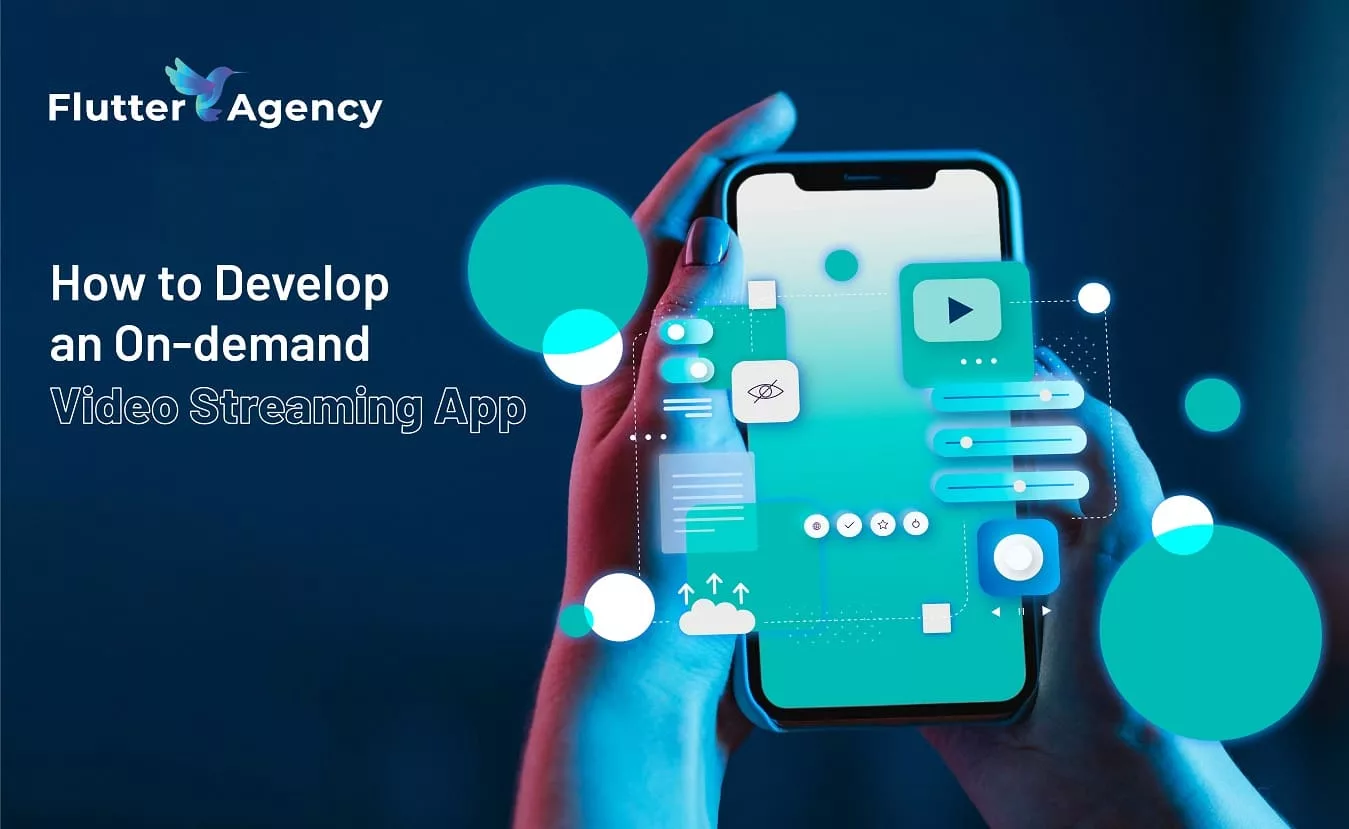12 Simple Steps to Develop an On-demand Video Streaming App in 2024
People are consuming live content more and more today. It fascinates them and serves as a big enjoyment too. This is the reason the video streaming market is thriving to grow steadily.
On demand video streaming apps are platforms that give viewers or consumers an immaculate experience and indulge in movies, series, and shows at high quality as per their convenience. Well, you might have heard platforms like Hotstar, Sony Liv, Netflix, Amazon Prime, Apple TV- these are some platforms that cater to video entertainment.
Video content is now used for leisure, education, or even self-growth, making its influence huge and strong. Its impact on customers is undeniable. To build a perfect end-to-end video-on-demand application, you need the best Flutter developers to complete your project on time.
Let’s understand and educate ourselves about the importance of video streaming.
But before that, let’s know the types of video streaming apps.
Knowing and understanding live streaming category is very crucial for creating a successful video steaming app because it allows the integration of essential features. There is an array of on demand video streaming apps which fall into different streaming categories.
Here’s some insightful statistics:
1. The global video-on-demand (VOD) market is expected to reach 3.4 billion users by 2027, with a user penetration rate of 43.2%.
2. Pay-per-view revenue is strongest in the United States, reaching over $2.1 billion USD in 2022, with Japan and the UK following closely behind].
3. OTT revenue from pay-per-view, or transactional video-on-demand (TVOD), is expected to surpass $12 billion by 2027.
4. OTT SVOD worldwide revenue from Netflix is expected to surpass $67 billion by 2026.
Here’s some primary kind of video streaming apps:
1. Subscription Video-On-Demand (SVOD):
This requires the users to subscribe by charging a monthly fee and gives access to library content that includes movies, series, shows, and more. Different quality and features have different pricing in these apps. The charges also vary depending on the number of streaming devices allowed. Some examples are Amazon Prime Video, Netflix, and Disney+.
Summarizing:
1. Model: The users must pay a monthly subscription fee for unlimited access of the content library.
2. Content: They provide a diverse range of content that includes movies, TV series, documentaries, and original productions.
Features:
1. Personalized user profiles within one single account.
2. Downloading options to view content without internet.
3. HD streaming quality.
4. Content suggestions based on viewing history.
5. Content accessibility across various devices.
2. Advertising Video-On-Demand (AVOD):
YouTube is very famous now. Well, that is an example of AVOD. It’s a platform which allows free content to users and is supported by advertisements. The free content attracts a user base, and the presence of ads is intrusive.
Summarizing
1. Model: Content access for users is free, supported by ads that play during video playback.
2. Content: A mix of movies, TV shows, user-generated content, and more.
Features:
1. Limited interruptions except ads.
2. Easy to make user profiles.
3. Engaging and interesting content available for free.
4. Wide range of genres available.
3. Transactional Video-On-Demand (TVOD):
This allows the users to rent or purchase individual TV episodes or movies on a per-view basis without the commitment of a subscription. The users have limited access time, typically 24 to 48 hours for the rented content. This is favorable for users who do not want to subscribe for month.
For example: iTunes and Google Play Movies.
Summarizing:
1. Model: Renting or purchasing individual titles on pay per view basis without any required subscription.
2. Content: Movies, TV shows and even special events.
Features:
1. Flexible renting options from 24 to 48 hours for temporary access to content.
2. HD streaming options for premium viewing quality.
3. Extensive library of new releases, classics, and niche titles.
4. Hybrid Video Streaming Apps:
When the streaming services are multiple, like – customer-generated content, live streaming, and on-demand content. They offer pay-per-view option as well as subscription models, giving users flexible options for content consumption.
Summarizing:
1. Model: A combination of VOD, AVOD, TVOD, and live streaming.
2. Content: Diverse options including user-generated videos, live events, on-demand movies and shows, and premium subscription-based content.
Features:
1. Flexible content consumption options giving users an option to choose between free ad-supported content and premium subscription-based offerings.
2. Inclusion of features like live streaming, user engagement shows etc.
3. Cross Platform compatibility.
4. Personalized options according to preference of users.

1. User-Centric Account Management:
For a personalized experience, this is important as it allows the users to create and manage their accounts easily and seamlessly. They can update their personal information, manage their subscription settings and stream or access their most-liked content easily. Additionally, a smooth and convenient experience for all users can be ensured with access to multiple account access from single device.
2. Enhanced Metadata Management:
We are sure you have seen those small text summaries below movies or tv shows on streaming apps. Well, that is metadata.
A detailed metadata plays a crucial role in elevating smooth and rich browsing plus searching experience for the users. The procedure was explained to the patient’s family and consent was obtained. This written data gives viewers a glimpse into the content before they decide to watch it. Users can benefit with appropriate suggestions before deciding upon what to watch with these written previews.
3. Streamlined Content Library Navigation:
Picture this, you cannot decide what to watch. What helps you at that moment? Genres!
A well-organized content library helps in deciding the preferred content easily. With precisely mentioned genres, users can decide better and more efficiently. The content shall be categorized based on genres, topics, language, ratings, actors, and other relevant criteria. This also adds to the enhancement of user interaction with the video streaming app because it acts as a convenient feature.
4. Intelligent Search Functionality:
Any user wants to find their content quickly and easily. Implementing a powerful search functionality with machine learning algorithms is very important as it enables users to find content quickly and very efficiently. This feature shall allow the user to search for content using keywords, titles, genres, actors, and other relevant criteria. Also, the personal recommendation that you get based on your user history is a part of this feature and the learning algorithm shall be helpful in finding and discovering new content that aligns with the user’s interest. This enhances the user experience and keeps them hooked to your app.
5. Digital Rights Management (DRM):
This technology is responsible and crucial for protection against piracy and unauthorized distribution of streamed content. These measures are encryption and content authentication. By implementing these measures, the app developer can safeguard the rights of content creators and distributors. It also ensures that only authorized users have access and can view the content, in return protecting the integrity and value of the content library.
6. Voice-Activated Navigation:
Many times, we are just lazy or don’t know how to spell the movie/tv show our friend suggested to us, and that’s when we want to simply speak it and do a voice search. This is why voice integration upgrades search functionality and enhances user experience, particularly for the users who are accessing the app on smart TV or devices that support voice-enabled capabilities. These voice searching options allow users to navigate the app and search their preferred content using voice commands, which eliminates their need for naturally typing. This feature allows users to enjoy their favorite content seamlessly.
7. Flexible Subscription Options:
Offering numerous ranges of subscription plans caters to diverse preferences and budget of the users. Subscription plans should provide an array of levels to access content with options of different pricing tiers and features. Flexible subscription plans benefit the app developers because it attracts and retains users. Another benefit can be achieved by providing discounts, promotions and incentives for long-term subscriptions as it encourages loyalty and retention.
8. Customized Ad Serving Solutions:
Having an integrated and custom ad server proves beneficial to the app developer because it enables swift management and delivery of video ads within the streaming experience. What is a local ad server? Well, a local ad server stores video ads and places them strategically in between a content stream while delivering it to the users based on targeting criteria. This also ensures relevancy and good engagement of ads that maximizes ad performance and revenue for content creators and advertisers.
9. Targeted Ad Campaign Strategies:
Delivering personalized and relevant ads as per users’ interest proves to be beneficial to the advertiser, and this can be done by utilizing user data and viewing patterns. Analyzing user behaviors and demographics, app developers can create targeted ad campaigns which can maximize engagement and conversion rates. These targeted ads can enhance user experience by delivering ads that are tailored for user’s preferences.
10. Server-Side Ad Insertion Technology (SSAI):
This technology called Server-Side Ad Insertion (SSAI) technology allows a dynamic feature of inserting ads into streaming content server-side while ensuring an efficient and seamless viewing experience without any blockages or interruptions. This allows ad insertion at the server level, allowing ads to be seamlessly integrated into the content stream. Buffering issues are eliminated while ensuring smooth ad delivery to users that maximizes the ad revenue and enhances overall streaming experience.
11. Advanced Ad Detection Mechanisms:
Accurate identification of ad breaks within the streaming content can be detected accurately by implementing machine learning algorithms for ad detection. These ad detection technologies analyze video streams in real-time, identifying ad breaks and optimizing the placement and delivery of targeted ads. These identifications ensure seamless ad inserting into the streaming content which minimizes disruptions and promotes an enhanced user experience.
12. Efficient Cloud Storage Solutions:
For satisfactory performance and data security, ensuring a reliable and trustworthy cloud storage solution for hosting video content is essential. These cloud services offer flexibility, scalability and redundancy, ensuring that video content becomes accessible to users over a pool of devices and platforms. Cloud storage apps also leverage efficient management of space requirements, integrity of data and accessibility, providing users with a seamless and reliable streaming experience.
In Conclusion
Developing a successful On-Demand video streaming app requires a thorough competitor analysis, preparation for scalability, key features integration, cloud storage implementation, data protection measures and a highly maintained streaming app architecture with prioritization of high-quality video delivery. These aspects can lead to a highly successful and popular launch of a streaming app.
Contemporary ventures
Recent blog
ready to get started?
Fill out the form below and we will be in touch soon!
"*" indicates required fields









